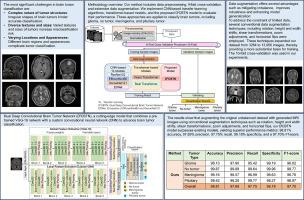基于双深度卷积网络的增强磁共振成像特征提取用于脑肿瘤的精确分类
IF 7.6
1区 计算机科学
Q1 COMPUTER SCIENCE, ARTIFICIAL INTELLIGENCE
引用次数: 0
摘要
准确可靠的脑肿瘤分类是有效医学诊断和制定靶向治疗策略的关键先决条件。脑肿瘤的复杂和多样的结构,如它们的纹理、大小和外观,对深度学习模型构成了重大挑战,通常会降低它们从磁共振成像扫描中识别肿瘤的准确性。为了应对这一挑战,我们引入了双深度卷积脑肿瘤网络,该网络将预先训练的视觉几何组19模型与定制设计的卷积神经网络相结合,以提取细粒度和高级肿瘤特征。通过结合这些互补的特征集,该模型提高了分类精度和鲁棒性,提供了对复杂脑肿瘤景观的全面理解。该模型的有效性通过使用Kaggle脑肿瘤分类数据集(包括胶质瘤、无肿瘤、脑膜瘤和垂体分类)的10倍交叉验证得到验证。实验结果表明,我们的模型优于现有的技术,达到98.81%的准确率,97.69%的精密度,97.75%的召回率,99.18%的特异性,f1评分为97.70%。这些结果证实了该综合模型为脑肿瘤分类提供了一个可靠、准确的解决方案,对临床诊断和治疗计划具有重要意义。本文章由计算机程序翻译,如有差异,请以英文原文为准。

Enhanced magnetic resonance imaging feature extraction for precise brain tumor classification using dual deep convolutional networks
Precise and reliable classification of brain tumors is a critical prerequisite for effective medical diagnostics and the development of targeted treatment strategies. The complex and diverse structures of brain tumors such as their texture, size, and appearance pose significant challenges for deep learning models, often reducing their accuracy in identifying tumors from magnetic resonance imaging scans. To tackle this challenge, we introduce the Dual Deep Convolutional Brain Tumor Network, which combines a pre-trained Visual Geometry Group 19 model with a custom-designed Convolutional Neural Network to extract both fine-grained and high-level tumor features. By combining these complementary feature sets, the model enhances classification accuracy and robustness, providing a comprehensive understanding of the complex brain tumor landscape. The model’s effectiveness was validated through 10-fold cross-validation using the Kaggle brain tumor classification dataset, encompassing glioma, no tumor, meningioma, and pituitary categories. Experimental findings reveal that our model surpasses existing techniques, attaining 98.81 % accuracy, 97.69 % precision, 97.75 % recall, 99.18 % specificity, and an F1-score of 97.70 %. These results confirm that the integrated model provides a reliable and accurate solution for brain tumor classification, with significant implications for clinical diagnostics and treatment planning.
求助全文
通过发布文献求助,成功后即可免费获取论文全文。
去求助
来源期刊

Knowledge-Based Systems
工程技术-计算机:人工智能
CiteScore
14.80
自引率
12.50%
发文量
1245
审稿时长
7.8 months
期刊介绍:
Knowledge-Based Systems, an international and interdisciplinary journal in artificial intelligence, publishes original, innovative, and creative research results in the field. It focuses on knowledge-based and other artificial intelligence techniques-based systems. The journal aims to support human prediction and decision-making through data science and computation techniques, provide a balanced coverage of theory and practical study, and encourage the development and implementation of knowledge-based intelligence models, methods, systems, and software tools. Applications in business, government, education, engineering, and healthcare are emphasized.
 求助内容:
求助内容: 应助结果提醒方式:
应助结果提醒方式:


